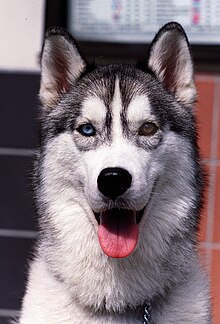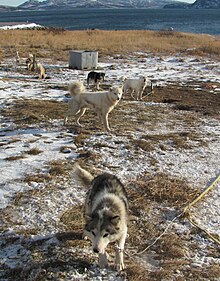
Husky is a general term for a dog used in the polar regions, primarily and specifically for work as sled dogs. It refers to a traditional northern type, notable for its cold-weather tolerance and overall hardiness.[1][2] Modern racing huskies that maintain arctic breed traits (also known as Alaskan huskies) represent an ever-changing crossbreed of the fastest dogs.[3][4]
Huskies have continued to be used in sled-dog racing, as well as expedition and trek style tour businesses, and as a means of essential transportation in rural communities.[5] Huskies are also kept as pets, and groups work to find new pet homes for retired racing and adventure-trekking dogs.[6]
History
[edit]
Nearly all dogs' genetic closeness to the gray wolf is due to admixture.[7] However, several Arctic breeds also show a genetic closeness with the now-extinct Taimyr wolf of North Asia due to admixture: the Siberian Husky and Greenland Dog (which are also historically associated with Arctic human populations) and to a lesser extent, the Shar Pei and Finnish Spitz. An admixture graph of the Greenland Dog indicates a best-fit of 3.5% shared material; however, an ancestry proportion ranging between 1.4% and 27.3% is consistent with the data and indicates admixture between the Taimyr wolf and the ancestors of these four high-latitude breeds.
This introgression could have provided early dogs living in high latitudes with phenotypic variation beneficial for adaption to a new and challenging environment, contributing significantly to the development of the husky. It also indicates that the ancestry of present-day dog breeds descends from more than one region.[8]
Etymology
[edit]
The term "husky" first came into usage in the mid to late 1700s. At this time, "Esquimaux" or "Eskimo" was a common term for pre-Columbian Arctic inhabitants of North America. Several dialectal permutations were in use including Uskee, Uskimay and Huskemaw. Thus, dogs used by Arctic people were the dogs of the Huskies, the Huskie's dogs, and eventually simply the husky dogs.[9][10] Canadian and American settlers, not well versed on Russian geography, would later extend the word to Chukotka sled dogs imported from Russia, thus giving rise to the term Siberian husky.
Characteristics
[edit]Huskies are energetic and athletic. They are distinguished by their hardiness and cold-weather tolerance, in contrast to many modern sprint sled dogs derived from hound and pointer crossbreeds and purebred sprinting dogs which do not have or retain these qualities.[11] Likewise, they are distinguished from laika, as they were not developed for the primary purpose of hunting game and prey animals.[12]
Huskies typically have a thick double coat that may come in a variety of colors.[13] The double coat generally protects huskies against harsh winters and, contrary to what most believe, they can survive in hotter climates. During the hotter climates, huskies tend to shed their undercoat regularly to cool their bodies. In addition to shedding, huskies control their eating habits based on the season; in cooler climates, they tend to eat generous amounts, causing their digestion to generate heat, whilst in warmer climates, they eat less.[14] Their eyes are typically pale blue, although they may also be brown, green, blue, yellow, or heterochromic. Huskies are more prone to some degree of uveitis than most other breeds.[15]
Breeds
[edit]
This is a list of dog breeds which contain "husky" in their name. To see a complete list of sled breeds, see Sled dog.
Alaskan husky
[edit]The most commonly used dog in dog sled racing,[16] the Alaskan husky is a mongrel[17] bred specifically for its performance as a sled dog.[18] The modern Alaskan husky reflects 100 years or more of crossbreeding with English Pointers, German Shepherd Dogs, Salukis and other breeds to improve its performance.[19] They typically weigh between 18 and 34 kg (40 and 75 lb) and may have dense or sleek fur. Alaskan huskies bear little resemblance to the typical husky breeds they originated from, or to each other.[18]

Labrador Husky
[edit]The Labrador Husky originated in the Canadian region of Labrador. The breed probably arrived in the area with the Inuit who came to Canada around 1300 AD. Despite the name, Labrador huskies are not related to the Labrador retriever, but in fact most closely related to the Canadian Eskimo Dog. There are estimated to be 50–60 Labrador huskies in the world.[20][21]
Mackenzie River Husky
[edit]The term Mackenzie River husky describes several overlapping historical populations of Arctic and sub-Arctic sled dog-type dogs, none of which constituted a breed. Dogs from the Yukon Territory were crossed with large European breeds such as St. Bernards and Newfoundlands to create a powerful freighting dog capable of surviving harsh arctic conditions during the Klondike Gold Rush.[22]

Sakhalin Husky
[edit]The Sakhalin Husky is a critically endangered landrace and sled laika associated with Sakhalin Island and adjacent areas.[23][24][25] They are also known Karafuto Ken, Sakhalin Laika, or Gilyak Laika.[26] While bred primarily as a sled dog, Sakhalin Huskies are also used for hunting bear and fishing.[18][25] There are approximately 20 Sakhalin Huskies remaining on Sakhalin Island.[25]
Siberian Husky
[edit]
The Siberian Husky is smaller than the similar-appearing Alaskan Malamute. They are descendants of the Chukotka sled dogs bred and used by the native Chukchi people of Siberia, a people of Paleosiberian origin, around the year 2000 BC.[27] Imported to Alaska in the early 1900s, they were used as working dogs and racing sled dogs in Nome, Alaska throughout the 1910s, often dominating the All-Alaska Sweepstakes.[28] They later became widely bred by recreational mushers and show-dog fanciers in the U.S. and Canada as the Siberian Husky, after the popularity garnered from the 1925 serum run to Nome.[29] Siberians stand 20–23.5 inches, weigh between 35 and 60lbs (35-50 for females, 45-60 for males), and have been selectively bred for both appearance and pulling ability.[30] They are still used regularly today as sled dogs by competitive, recreational, and tour-guide mushers.[31]
See also
[edit]External links
[edit] Media related to Husky at Wikimedia Commons
Media related to Husky at Wikimedia Commons
References
[edit]- ^ H., Bonham, Margaret (2001). Northern breeds. Barron's. OCLC 1245640121.
((cite book)): CS1 maint: multiple names: authors list (link) - ^ "Sled Dog Central : A Deeper History of the Origins of the Alaskan Husky by Stephanie Little Wolf". www.sleddogcentral.com. Retrieved 2022-01-13.
- ^ Schultz, Jeff (28 January 2003). Dogs of the Iditarod. Seattle: Sasquatch Books. p. 41. ISBN 1-57061-292-7.
- ^ D. K. (2013-10-01). The dog encyclopedia. Dennis-Bryan, Kim, Baggaley, Ann, John, Katie, DK Publishing, Inc. (First American ed.). New York. p. 103. ISBN 9781465421166. OCLC 859155647.
((cite book)): CS1 maint: location missing publisher (link) - ^ Neary, Kathleen (2008-01-14). "How Sled Dogs Work". Retrieved 3 June 2015.
- ^ Keith, Christie (18 February 2011). "Lessons from a sled dog massacre". sfgate. Retrieved 3 June 2015.
- ^ Freedman, A. H.; Gronau, I.; Schweizer, R. M.; Ortega-Del Vecchyo, D.; Han, E.; Silva, P. M.; Galaverni, M.; Fan, Z.; Marx, P.; Lorente-Galdos, B.; Beale, H.; Ramirez, O.; Hormozdiari, F.; Alkan, C.; Vilà, C.; Squire, K.; Geffen, E.; Kusak, J.; Boyko, A. R.; Parker, H. G.; Lee, C.; Tadigotla, V.; Siepel, A.; Bustamante, C. D.; Harkins, T. T.; Nelson, S. F.; Ostrander, E. A.; Marques-Bonet, T.; Wayne, R. K.; Novembre, J. (2014). "Genome Sequencing Highlights the Dynamic Early History of Dogs". PLOS Genetics. 10 (1): e1004016. doi:10.1371/journal.pgen.1004016. PMC 3894170. PMID 24453982.
- ^ Skoglund, P.; Ersmark, E.; Palkopoulou, E.; Dalén, L. (2015). "Ancient Wolf Genome Reveals an Early Divergence of Domestic Dog Ancestors and Admixture into High-Latitude Breeds". Current Biology. 25 (11): 1515–9. doi:10.1016/j.cub.2015.04.019. PMID 26004765.
- ^ Harper, Kenn (2007-09-28). "The Evolution of a Word Husky". Nunatsiaq News. Retrieved 2022-02-22.
- ^ Dalziel, Hugh (1879). British dogs; their varieties, history, characteristics, breeding, management and exhibition. University of California Libraries. London, The bazaar office. pp. 205–213.
- ^ Brown, S K; Darwent, C M; Wictum, E J; Sacks, B N (2015-06-24). "Using multiple markers to elucidate the ancient, historical and modern relationships among North American Arctic dog breeds". Heredity. 115 (6): 488–495. doi:10.1038/hdy.2015.49. ISSN 0018-067X. PMC 4806895. PMID 26103948.
- ^ VLADIMIR., BEREGOVOY (2019). HUNTING LAIKA BREEDS OF RUSSIA. ROSEDOG PR. ISBN 978-1-64426-696-0. OCLC 1231601344.
- ^ The Oxford Pocket Dictionary of Current English 2009 online http://www.encyclopedia.com/topic/husky.aspx
- ^ "Eating Habits of Siberian Huskies". Pets - The Nest. Retrieved 2020-09-04.
- ^ Uveodermatologic syndrome, http://www.vetmed.ucdavis.edu/courses/vet_eyes/conotes/con_chapter_11.html Archived 2012-06-06 at the Wayback Machine
- ^ "Sled Dogs: An Alaskan Epic ~ About | Nature | PBS". Nature. 1999-11-21. Retrieved 2021-07-26.
- ^ "Sled Dogs in the North | Yukon Quest". www.yukonquest.com. Retrieved 2021-07-26.
- ^ a b c Cary, Bob (2009). Born to pull : the glory of sled dogs. Internet Archive. Minneapolis : University of Minnesota Press. ISBN 978-0-8166-6773-4.
- ^ Brown, S K; Darwent, C M; Wictum, E J; Sacks, B N (December 2015). "Using multiple markers to elucidate the ancient, historical and modern relationships among North American Arctic dog breeds". Heredity. 115 (6): 488–495. doi:10.1038/hdy.2015.49. ISSN 0018-067X. PMC 4806895. PMID 26103948.
- ^ Hoyles, Samantha (Summer 2017). "The Great Labrador Husky". Inside Labrador: 60–64.
- ^ Losey, Robert J.; Wishart, Robert P.; Loovers, Jan Peter Laurens, eds. (2018-06-13). Dogs in the North: Stories of Cooperation and Co-Domestication. Routledge.
- ^ MacQuarrie, Gordon (December 1997). "Kenai, Dog of Alaska". The Gordon MacQuarrie Sporting Treasury: 98–99.
- ^ Niramin (2017-01-12). "Сахалинский хаски - исчезающая порода. Редкие фотографии собак в галерее. » Дикая граница" [The Sakhalin Husky is an Endangered Breed.]. Дикая граница. Retrieved 2022-04-01.
- ^ Yasko, Kirill (2015-10-31). "Последний каюр псов Карафуто. Сахалин.Инфо" [The Last Musher of the Karafuto Dogs]. sakhalin.info (in Russian). Retrieved 2022-04-01.
- ^ a b c Пасюков, Пётр (2020-10-08). "БЕЛЫЙ СОН" [White Dream]. ОСТРОВ 2049 (in Russian). Retrieved 2023-05-15.
- ^ Панкстьянов, Даниил (2023-02-21). "На Сахалине пытаются сохранить уникальную породу собак" [On Sakhalin, they are trying to save a unique breed of dogs]. Комсомольская правда (in Russian). Retrieved 2023-05-16.
- ^ "Siberian Husky". 15 December 2018.
- ^ Thomas, Bob; Thomas, Pat (2015). Leonhard Seppala: the Siberian dog and the golden age of sleddog racing 1908-1941. Missoula, Montana: Pictorial Histories Publishing Company. ISBN 978-1-57510-170-5. OCLC 931927411.
- ^ "Siberian Husky History". Siberian Husky Club of America, Inc. Retrieved 2021-07-26.
- ^ "The Siberian Husky Standard". Siberian Husky Club of America, Inc. Retrieved 2021-07-26.
- ^ "Do many Siberian Huskies run the Iditarod? If not, why? – Iditarod". iditarod.com. 12 October 2020. Retrieved 2021-07-26.
External links
[edit]| Types | |
|---|---|
| Breeds | |
| Roles | |
| Behavior | |
| Human–dog interaction | |
| Health | |
| Training | |
| Related | |
Primitive dogs | |
|---|---|
| Primitive hounds | |
| Landrace dogs | |
| Wild dogs | |
| Hairless breeds | |
| Extinct breeds | |